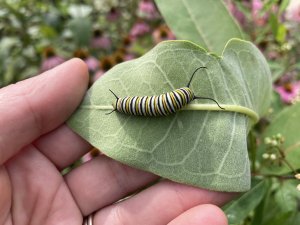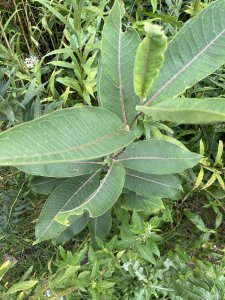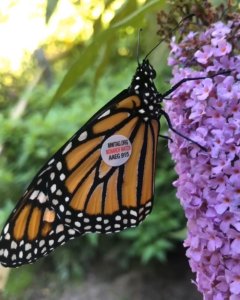Miles of Milkweed for Monarchs
September 18, 2024
By: Alexis Olechowski, Interpretive Staff
Butterflies captivate us with their delicate fluttering and vibrant colors, and among them, the Monarch butterfly is especially remarkable due to its awe-inspiring mass migration. Each autumn, North American Monarchs migrate from their summer breeding grounds to overwintering sites. West of the Rockies, they travel to the Pacific coast of central and southern California. The eastern population migrates from southern Canada to the Monarch Biosphere Reserve in Mexico’s mountains.
In recent decades, both Monarch populations have faced severe threats, leading to drastic declines. The eastern population has suffered a staggering reduction of up to 90 percent, while the western population has plummeted by over 99 percent. The latest survey from The Xerces Society for Invertebrate Conservation, released on January 30, 2024, revealed a 30% decline from the previous year making todays population counts only 5% of the millions recorded in the 1980s. Habitat loss, fragmentation, degradation, pesticides, and climate change are primary contributors to this decline. With their populations reduced, Monarchs are more vulnerable to environmental stressors, pushing them closer to extinction.
We often see advertisements for milkweed and other pollinator-friendly plants, but what do they mean for monarch butterflies? How is planting these plants crucial for their survival and that of other pollinators? Let’s explore these questions by understanding the butterfly-plant relationship more deeply.

Host plants and gardening for every stage of the butterfly life cycle
A host plant provides essential food, shelter, habitat, or breeding sites for another organism. Imagine the pickiest eater you know—they might not like many foods but still eat more than one thing. Now, picture having only one food you can eat. This is the reality for insects dependent on specific host plants. For monarch butterflies, that plant is milkweed. Monarchs lay their eggs exclusively on milkweed, and the larvae feed on it before becoming adults. Without milkweed, monarchs cannot complete their life cycle, leading to population declines.
Now, think of that host plant as the only restaurant you can eat at. Imagine the difficulty of always seeking out that one place when you’re hungry, especially if you travel to a state without it. This is similar to monarch migration and milkweed availability. Monarchs travel great distances, taking 3-4 generations to reach the northern U.S. and Canada. Host plants along their path are vital for their success. Without milkweed as breeding grounds along the way, their journey would be too long for them to complete in their short lifespans.
This unique dependence is why Monarch enthusiasts across the country plant milkweed to support monarch populations. Making milkweed as accessible to monarchs as gas stations are to cars is just the start. Many native plants have similar relationships with other insects and serve as “host plants” for various pollinators. Adding these to your yard makes you an essential part of the ecosystem.
When planting for monarchs or other pollinators, remember that host plants are meant to be eaten. If you see chewed

leaves, don’t spray pesticides, it’s often caterpillars of the butterflies you wanted, not pests. Like “The Very Hungry Caterpillar,” they need to eat a lot to grow and transform into butterflies. Pesticides can poison everything relying on the plant, including leaves and pollen, harming butterflies, bees, and birds.
Embrace nibbled leaves as signs that you’re supporting these creatures’ life cycle. Most plants have evolved to survive hosting insects because the benefits outweigh the harm. So, let them eat milkweed and avoid the pesticides. Each plant choice creates habitat for pollinators of all shapes and sizes. Having these plants accessible in more backyards creates a network of food, shelter, and breeding sites for migratory species and local pollinators.
Climate impacts on Monarch migration
While pesticide-free food is crucial for their journey, it’s not the only factor affecting monarch butterflies. Monarchs, usually renowned for their migration, have started to opt out of the journey altogether. This has always been the case in some areas; for instance, monarchs in southern Florida remain year-round without migrating. Scientists are uncertain if these resident monarchs avoid migration due to mild winters, genetic differences, or a combination of factors.
Last year, the fall monarch migration in Texas was smaller and later than usual, likely due to climate change. Severe droughts over the summer and fall reduced milkweed availability, which is crucial for monarch reproduction. Additionally, warmer weather and accessible milkweed farther north likely discouraged migration. Climate change-induced extreme weather patterns and warmer winters further exacerbate this issue.

Conservationists are concerned that these trends may eventually disrupt the annual monarch migration, potentially leading to an increase in non-migratory populations. Can we fault the monarchs for avoiding such a lengthy journey if they can? If true, this directly signals shifting climates and evolving animal behaviors.
The impact of one butterfly opting out of the journey to its typical overwintering and breeding grounds might seem trivial, but consider the loss of genetic diversity when populations remain in small, isolated clusters across the country instead of mingling into a cohesive whole. These smaller, more stationary groups are prone to inbreeding and genetic decline over time. Moreover, unpredictable weather patterns can imperil the survival of these non-migratory populations, disrupting natural cycles and cues.
Taking action to support healthy monarch populations now and into the future
So, where do we proceed from here? Restoring the monarch population demands a blend of strategies—short-term and long-term, local and national, individual, communal, and regional. Encouragingly, there is no shortage of actions individuals can take to support these beloved butterflies, and people across the nation have already rallied to assist.
Initiating change begins with rethinking the role our yards play and whom they serve. The plants we choose and the chemicals we employ—or avoid—carry implications far beyond just curb appeal. Planting with both human enjoyment and pollinator needs in mind can be mutually beneficial. Fortunately, milkweed and other “host plants” not only enhance visual appeal and emit pleasant fragrances for us but also serve as vital resources for butterflies and bees. Your yard thus becomes an ecosystem that could serve as a crucial layover for monarchs traveling long distances in search of summer sustenance and breeding grounds.
Resources:
Regional native plant lists for Michigan gardeners
Friends of the Rouge Native Plant Market
Washtenaw County Conservation District Fall Tree and Native Plant Sale
